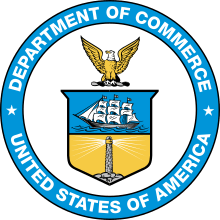National Oceanic and Atmospheric Administration
The National Oceanic and Atmospheric Administration (NOAA /ˈnoʊ.ə/ NOH-ə) is an American scientific agency within the United States Department of Commerce that focuses on the conditions of the oceans, major waterways, and the atmosphere.
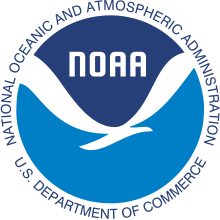 Logo of the National Oceanic and Atmospheric Administration | |
| Agency overview | |
|---|---|
| Formed | February 10, 1807 Reestablished: October 3, 1970 |
| Preceding agency |
|
| Jurisdiction | US Federal Government |
| Headquarters | Silver Spring, Maryland, US 38°59′32.1″N 77°01′50.3″W |
| Employees |
|
| Annual budget | US$5.6 billion (est. 2011) |
| Agency executive |
|
| Parent agency | US Department of Commerce |
| Website | NOAA.gov |
| Footnotes | |
| [1][2][3][4] | |
NOAA warns of dangerous weather, charts seas, guides the use and protection of ocean and coastal resources and conducts research to provide the understanding and improve stewardship of the environment.
Purpose and function

NOAA's specific roles include:
- Supplying Environmental Information Products. NOAA supplies to its customers and partners information pertaining to the state of the oceans and the atmosphere. This is clear through the production of weather warnings and forecasts via the National Weather Service, but NOAA's information products extend to climate, ecosystems, and commerce as well.
- Providing Environmental Stewardship Services. NOAA is a steward of U.S. coastal and marine environments. In coordination with federal, state, local, tribal and international authorities, NOAA manages the use of these environments, regulating fisheries and marine sanctuaries as well as protecting threatened and endangered marine species.
- Conducting Applied Scientific Research. NOAA is intended to be a source of accurate and objective scientific information in the four particular areas of national and global importance identified above: ecosystems, climate, weather and water, and commerce and transportation.[5]
The five "fundamental activities" are:
- Monitoring and observing Earth systems with instruments and data collection networks.
- Understanding and describing Earth systems through research and analysis of that data.
- Assessing and predicting the changes in these systems over time.
- Engaging, advising, and informing the public and partner organizations with important information.
- Managing resources for the betterment of society, economy, and environment.[6]
History
NOAA traces its history back to multiple agencies,[7] some of which were among the oldest in the federal government:[8]
- United States Coast and Geodetic Survey, formed in 1807.
- Weather Bureau of the United States, formed in 1870.
- Bureau of Commercial Fisheries, formed in 1871 (research fleet-only).
- Coast and Geodetic Survey Corps, formed in 1917.
Another direct predecessor of NOAA was the Environmental Science Services Administration (ESSA), into which several existing scientific agencies such as the United States Coast and Geodetic Survey, the Weather Bureau and the uniformed Corps were absorbed in 1965.[8]
NOAA was established within the Department of Commerce via the Reorganization Plan No. 4[8] and formed on October 3, 1970, after U.S. President Richard Nixon proposed creating a new agency to serve a national need for "better protection of life and property from natural hazards… for a better understanding of the total environment… [and] for exploration and development leading to the intelligent use of our marine resources". NOAA is a part of the Department of Commerce rather than the Department of Interior because of a feud between President Nixon and his interior secretary, Wally Hickel, over the Nixon Administration's Vietnam War policy. Nixon did not like Hickel's letter urging Nixon to listen to the Vietnam War demonstrators,[9] and thus punished Hickel by not putting NOAA in the Interior Department.[10]
In 2007, NOAA celebrated 200 years of service in its role as successor to the United States Survey of the Coast.[11] In 2013, NOAA closed 600 weather stations.[12]
NOAA was officially formed in 1970[13] and in 2017 had over 11,000 civilian employees.[3] Its research and operations are further supported by 321 uniformed service members who make up the NOAA Commissioned Corps.[14]
Since February 2019, NOAA has been headed by Neil Jacobs, acting Under Secretary of Commerce for Oceans and Atmosphere and NOAA interim administrator. NOAA has not had a confirmed leader since January 2017. Trump nominated Jacobs to be the 11th administrator in December 2019, one month after his previous nominee Barry Myers withdrew for health reasons.[15]
Organizational structure
_and_East-West_Highway_(Maryland_State_Route_410)_in_Silver_Spring%2C_Montgomery_County%2C_Maryland.jpg)
NOAA Administrator
Since February 25, 2019, Neil Jacobs, Assistant Secretary of Commerce for Environmental Observation and Prediction, has served as acting Under Secretary of Commerce for Oceans and Atmosphere at the US Department of Commerce and NOAA's interim administrator.[16]
Jacobs succeeded Timothy Gallaudet who succeeded Benjamin Friedman. The three have served in series as NOAA's interim administrator since the end of the Obama Administration on January 20, 2017.[17] In October 2017, Barry Lee Myers, CEO of AccuWeather, was proposed to be the agency's administrator by the Trump Administration.[18] After two years in the nomination process, on November 21, 2019, Myers withdrew his name from consideration due to health concerns.[19]
NOAA Services
NOAA works toward its mission through six major line offices, the National Environmental Satellite, Data and Information Service (NESDIS), the National Marine Fisheries Service (NMFS), the National Ocean Service (NOS), the National Weather Service (NWS), the Office of Oceanic and Atmospheric Research (OAR) and the Office of Marine & Aviation Operations (OMAO).[20] and in addition more than a dozen staff offices, including the Office of the Federal Coordinator for Meteorology, the NOAA Central Library, the Office of Program Planning and Integration (PPI).[20]
National Weather Service
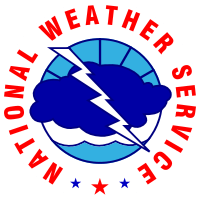
The National Weather Service (NWS) is tasked with providing "weather, hydrologic and climate forecasts and warnings for the United States, its territories, adjacent waters and ocean areas, for the protection of life and property and the enhancement of the national economy."[21] This is done through a collection of national and regional centers, 13 river forecast centers (RFCs), and more than 120 local weather forecast offices (WFOs).[22] They are charged with issuing weather and river forecasts, advisories, watches, and warnings on a daily basis. They issue more than 734,000 weather and 850,000 river forecasts, and more than 45,000 severe weather warnings annually. NOAA data is also relevant to the issues of global warming and ozone depletion.[23]
The NWS operates NEXRAD, a nationwide network of Doppler weather radars which can detect precipitation and their velocities. Many of their products are broadcast on NOAA Weather Radio, a network of radio transmitters that broadcasts weather forecasts, severe weather statements, watches and warnings 24 hours a day.[24]
National Ocean Service
The National Ocean Service (NOS) focuses on ensuring that ocean and coastal areas are safe, healthy, and productive. NOS scientists, natural resource managers, and specialists serve America by ensuring safe and efficient marine transportation, promoting innovative solutions to protect coastal communities, and conserving marine and coastal places.[25]
The National Ocean Service is composed of eight program offices: the Center for Operational Oceanographic Products and Services,[26] the Coastal Services Center,[27] the National Centers for Coastal Ocean Science,[28] the Office of Coast Survey,[29] the Office of National Geodetic Survey,[30] the Office of National Marine Sanctuaries[31] the Office of Ocean and Coastal Resource Management[32] and the Office of Response and Restoration.[33]
There are two NOS programs, namely the Mussel Watch Contaminant Monitoring Program and the NOAA Integrated Ocean Observing System (IOOS) and two staff offices, the International Program Office and the Management and Budget Office.
National Environmental Satellite, Data, and Information Service
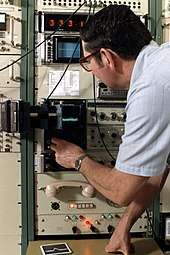
The National Environmental Satellite, Data, and Information Service (NESDIS) was created by NOAA to operate and manage the US environmental satellite programs, and manage NWS data and those of other government agencies and departments. NESDIS's National Centers for Environmental Information (NCEI) archives data collected by the NOAA, U.S. Navy, U.S. Air Force, the Federal Aviation Administration, and meteorological services around the world and comprises the Center for Weather and Climate (previously NOAA's National Climatic Data Center), the Center for Coasts, Oceans, and Geophysics (created by a merger of NOAA's National Coastal Data Development Center (NCDDC), National Oceanographic Data Center (NODC), and the National Geophysical Data Center (NGDC)).
In 1960, TIROS-1, NASA's first owned and operated geostationary satellite, was launched. Since 1966, NESDIS has managed polar orbiting satellites (POES) and since 1974 it has operated geosynchronous satellites (GOES). In 1979, NOAA's first polar-orbiting environmental satellite was launched. Current operational satellites include NOAA-15, NOAA-18, NOAA-19, GOES 13, GOES 14, GOES 15, Jason-2 and DSCOVR. In 1983, NOAA assumed operational responsibility for Landsat satellite system.[34]
Since May 1998, NESDIS has operated the Defense Meteorological Satellite Program (DMSP) satellites on behalf of the Air Force Weather Agency.[35]
New generations of satellites are developed to succeed the current polar orbiting and geosynchronous satellites, the Joint Polar Satellite System) and GOES-R, which is scheduled for launch in March 2017.[36][37]
NESDIS runs the Office of Projects, Planning, and Analysis (OPPA) formerly the Office of Systems Development,[38] the Office of Satellite Ground Systems (formerly the Office of Satellite Operations)[39] the Office of Satellite and Project Operations,[40] the Center for Satellite Applications and Research (STAR)],[41] the Joint Polar Satellite System Program Office[42] the GOES-R Program Office, the International & Interagency Affairs Office, the Office of Space Commercialization[43] and the Office of System Architecture and Advanced Planning.
National Marine Fisheries Service
The National Marine Fisheries Service (NMFS), also known as NOAA Fisheries, was initiated in 1871 with a primary goal of the research, protection, management, and restoration of commercial and recreational fisheries and their habitat, and protected species. NMFS operates twelve headquarters offices, five regional offices, six fisheries science centers, and more than 20 laboratories throughout the United States and U.S. territories, which are the sites of research and management of marine resources. NMFS also operates the National Oceanic and Atmospheric Administration Fisheries Office of Law Enforcement in Silver Spring, Maryland, which is the primary site of marine resource law enforcement.
Office of Oceanic and Atmospheric Research
NOAA's research, conducted through the Office of Oceanic and Atmospheric Research (OAR), is the driving force behind NOAA environmental products and services that protect life and property and promote economic growth. Research, conducted in OAR laboratories and by extramural programs, focuses on enhancing our understanding of environmental phenomena such as tornadoes, hurricanes, climate variability, solar flares, changes in the ozone, air pollution transport and dispersion,[44][45] El Niño/La Niña events, fisheries productivity, ocean currents, deep sea thermal vents, and coastal ecosystem health. NOAA research also develops innovative technologies and observing systems.
The NOAA Research network consists of seven internal research laboratories, extramural research at 30 Sea Grant university and research programs, six undersea research centers, a research grants program through the Climate Program Office, and 13 cooperative institutes with academia. Through NOAA and its academic partners, thousands of scientists, engineers, technicians, and graduate students participate in furthering our knowledge of natural phenomena that affect the lives of us all.[46][47]
The Air Resources Laboratory (ARL) is one of the laboratories in the Office of Oceanic and Atmospheric Research. It studies processes and develops models relating to climate and air quality, including the transport, dispersion, transformation and removal of pollutants from the ambient atmosphere. The emphasis of the ARL's work is on data interpretation, technology development and transfer. The specific goal of ARL research is to improve and eventually to institutionalize prediction of trends, dispersion of air pollutant plumes, air quality, atmospheric deposition, and related variables.[48][49]
The Atlantic Oceanographic and Meteorological Laboratory (AOML), is part of NOAA's Office of Oceanic and Atmospheric Research, located in Miami, Florida. AOML's research spans hurricanes, coastal ecosystems, oceans, and human health, climate studies, global carbon systems, and ocean observations. AOML's organizational structure consists of an Office of the Director and three scientific research divisions (Physical Oceanography, Ocean Chemistry and Ecosystems, and Hurricane Research). The Office of the Director oversees the Laboratory's scientific programs, as well as its financial, administrative, computer, outreach/education, and facility management services. Research programs are augmented by the Cooperative Institute for Marine and Atmospheric Studies (CIMAS), a joint enterprise with the University of Miami's Rosenstiel School of Marine and Atmospheric Science. CIMAS enables AOML and university scientists to collaborate on research areas of mutual interest and facilitates the participation of students and visiting scientists. AOML is a member of a unique community of marine research and educational institutions located on Virginia Key in Miami, Florida.[50]
In 1977, the Pacific Marine Environmental Laboratory (PMEL) deployed the first successful moored equatorial current meter – the beginning of the Tropical Atmosphere Ocean, TAO, array. In 1984, the Tropical Ocean-Global Atmosphere program (TOGA) program began.
The Arctic Report Card is the Annual update charts of the ongoing impact of changing conditions on the environment and community by NOAA. It was compiled by 81 scientists from 12 nations in the year 2019.[51]
Office of Marine and Aviation Operations
The Office of Marine and Aviation Operations is responsible for the fleet of NOAA ships, aircraft, and diving operations. It has the largest research fleet of the Federal government. Its personnel is made up of civilians and the NOAA Commissioned Corps.[52] The office is headed by a NOAA Corps two-star rear admiral, who also commands the Corps.[53]
National Geodetic Survey
The National Geodetic Survey (NGS) is the primary surveying organization in the United States.
National Integrated Drought Information System
The National Integrated Drought Information System is a program within NOAA with an interagency mandate to coordinate and integrate drought research, building upon existing federal, tribal, state, and local partnerships in support of creating a national drought early warning information system.[54]
NOAA Commissioned Officer Corps
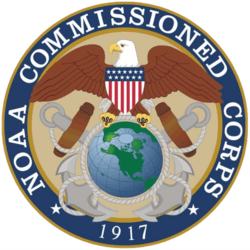
The NOAA Commissioned Officer Corps is a uniformed service of men and women who operate NOAA ships and aircraft, and serve in scientific and administrative posts.[55]
Intergovernmental Panel on Climate Change
Since 2001, the organization has hosted the senior staff and recent chair, Susan Solomon, of the Intergovernmental Panel on Climate Change's working group on climate science.[56]
Hurricane Dorian controversy
Hurricane Dorian was an extremely powerful and destructive tropical cyclone that devastated the northwestern Bahamas and caused significant damage to the Southeastern United States and Atlantic Canada in September 2019. By September 1, NOAA had issued a statement saying that the "current forecast path of Dorian does not include Alabama". However, on that date, President Donald Trump tweeted that Alabama, among other states, "will most likely be hit (much) harder than anticipated". Shortly thereafter, the Birmingham, Alabama office of the National Weather Service issued a tweet that appeared to contradict Trump, saying that Alabama "will NOT see any impacts from Dorian" On September 6, NOAA published a statement from an unidentified spokesperson supporting Trump's September 1 claim. The statement also labelled the Birmingham, Alabama branch of the National Weather Service's contradiction of Trump as incorrect.[57][58][59] The New York Times reported that the NOAA September 6 statement was prompted by a threat from U.S. Commerce Secretary Wilbur Ross to fire high-level NOAA staff unless they supported President Trump's claim. The Department of Commerce described this report as "false".[60][61] Meanwhile, The Washington Post reported that NOAA had twice ordered National Weather Service employees not to provide "any opinion" on Hurricane Dorian and to "only stick with official National Hurricane Center forecasts". The first order came after Trump's September 1 comments and the Birmingham, Alabama National Weather Service's contradiction of Trump. The second-order came on September 4 after Trump displayed an August 29 map that was altered with a black marker to show that Hurricane Dorian may hit Alabama.[62]
On September 9, speaking at an Alabama National Weather Service (NWS) meeting the Director of the National Weather Service gave a speech supporting Birmingham NWS and said the team "stopped public panic" and "ensured public safety". He said that when Birmingham issued their instructions they were not aware that the calls they were receiving were a result of Trump's tweet. The acting chief scientist and assistant administrator for the ocean and atmospheric research said he is "pursuing the potential violations" of the agency's scientific integrity policy.[63]
Flag

The NOAA flag is a modification of the flag of one of its predecessor organizations, the United States Coast and Geodetic Survey. The Coast and Geodetic Survey's flag, authorized in 1899 and in use until 1970, was blue, with a white circle centered in it and a red triangle centered within the circle. It symbolized the use of triangulation in surveying, and was flown by ships of the Survey.[64]
When NOAA was established in 1970 and the Coast and Geodetic Survey's assets became a part of NOAA, NOAA based its own flag on that of the Coast and Geodetic Survey. The NOAA flag is, in essence, the Coast and Geodetic Survey flag, with the NOAA logo—a circle divided by the silhouette of a seabird into an upper dark blue and a lower light blue section, but with the "NOAA" legend omitted—centered within the red triangle. NOAA ships in commission display the NOAA flag; those with only one mast fly it immediately beneath the ship's commissioning pennant or the personal flag of a civilian official or flag officer if one is aboard the ship, while multi masted vessels fly it at the masthead of the forwardmost mast.[65] NOAA ships fly the same ensign as United States Navy ships but fly the NOAA flag as a distinguishing mark to differentiate themselves from Navy ships.
See also
- Center for Environmental Technology (CET)
- Climate Mirror
- Federation of Earth Science Information Partners (ESIP Federation)
- List of auxiliaries of the United States Navy – Wikipedia list article
- Marine Mammal Protection Act
- Minerals Management Service
- NOAA's Environmental Real-time Observation Network
- SciLands, also known as NOAA's Virtual World Program
- Office of Naval Research
- Title 15 of the Code of Federal Regulations
- United States Naval Research Laboratory
- University-National Oceanographic Laboratory System
- Volcanic Ash Advisory Center
- Weather Modification Operations and Research Board
References
- Celebrating 200 Years NOAA website, 2007.
- "About Our Agency | National Oceanic and Atmospheric Administration". NOAA.gov. Retrieved 2016-04-03.
- "BestPlacesToWork.org Agency Report". Best Places to Work. Retrieved 1 Jul 2014.
- "Organizational Structure | National Oceanic and Atmospheric Administration". NOAA.gov. 5 March 2018. Archived from the original on 13 July 2018. Retrieved 13 July 2018.
- "About the National Oceanic and Atmospheric Administration (NOAA)". Retrieved 2016-05-18.
- "New Priorities for the 21st Century NOAA STRATEGIC PLAN FY 2005 – FY 2010" (PDF). oceanservice.noaa.gov. U.S. Department of Commerce, National Oceanic and Atmospheric Administration, Office of Program Planning and Integration, NOAA Strategic Planning. Archived from the original (PDF) on 10 June 2016. Retrieved 30 May 2013.
- "Our history | National Oceanic and Atmospheric Administration". Noaa.gov. Retrieved 2017-06-13.
- "Reorganization Plan 4 - 197 - NOAA Central Library". Lib.noaa.gov. Archived from the original on 2016-03-04. Retrieved 2016-04-03.
- "The Battle for the National Oceanic and Atmospheric Administration (NOAA)". Steven Eli Schanes. 2008-05-22. Retrieved 2019-12-09.
- MervisJan. 13, Jeffrey; 2012; Pm, 2:28 (2012-01-13). "Why NOAA Is in the Commerce Department". Science | AAAS. Retrieved 2019-12-09.CS1 maint: numeric names: authors list (link)
- Shea, Eileen. "A History of NOAA". Department of Commerce Historical Council. Retrieved 30 May 2013.
- Lott, Maxim (13 August 2013). "Distorted data? Feds close 600 weather stations amid criticism they're situated to report warming". Fox News. Retrieved 26 July 2018.
- "Our history | National Oceanic and Atmospheric Administration". NOAA.gov. Retrieved 2017-06-13.
- "About | Office of Marine and Aviation Operations". NOAA.gov. Retrieved 19 February 2018.
- Hotakainen, Rob (18 December 2019). "Trump nominates acting NOAA leader to be permanent chief". Science Magazine. Retrieved 13 February 2020.
- "Dr. Neil Jacobs". U.S. Department of Commerce. Retrieved 2019-12-13.
- "Benjamin Friedman | National Oceanic and Atmospheric Administration". Noaa.gov. Retrieved 2017-06-13.
- "Trump administration nominates AccuWeather CEO Barry Myers to head NOAA - Geospatial World". Geospatial World. 2017-10-25. Retrieved 2017-10-25.
- Freedman, Andrew; Samenow, Jason (2019-11-20). "White House pick to lead NOAA withdraws nomination, citing health concerns". Washington Post. ISSN 0190-8286. Retrieved 2019-12-03.
- "Organization | National Oceanic and Atmospheric Administration". Noaa.gov. 2016-03-30. Retrieved 2016-04-03.
- "Weather | National Oceanic and Atmospheric Administration". noaa.gov. September 24, 2019. Retrieved September 24, 2019.
- "NWS: Forecasts and Service". www.weather.gov. Retrieved September 24, 2019.
- "4 ways the ozone hole is linked to climate, and 1 way it isn't | NOAA Climate.gov". www.climate.gov. Retrieved 2019-12-13.
- Service, US Department of Commerce, NOAA, National Weather. "NOAA Weather Radio". Weather.gov. Retrieved 2017-01-30.
- "NOS: About Us". oceanservice.noaa.gov. Retrieved September 24, 2019.
- "NOAA Tides & Currents". tidesandcurrents.noaa.gov. Retrieved 19 August 2017.
- NOAA Office for Coastal Management ADS Group. "NOAA Office for Coastal Management". Csc.noaa.gov. Retrieved 2016-04-03.
- "Home - NOAA Tides & Currents". Tidesandcurrents.noaa.gov. 2013-10-15. Retrieved 2016-04-03.
- "Nautical Charts & Pubs". Nauticalcharts.noaa.gov. Retrieved 2016-04-03.
- "National Geodetic Survey - Home". Geodesy.noaa.gov. Retrieved 2016-04-03.
- "NOAA National Marine Sanctuaries". Sanctuaries.noaa.gov. Retrieved 2016-04-03.
- "Archived copy". Archived from the original on October 27, 2006. Retrieved October 25, 2006.CS1 maint: archived copy as title (link)
- "Our role is stewardship; our product is science". Response.restoration.noaa.gov. 1989-03-24. Retrieved 2016-04-03.
- "Landsat Data Data Sheet". usgs.gov. 1997.
- "Department of Commerce". history.nasa.gov. Retrieved 2017-05-28.
- "NASA Successfully Launches NOAA Advanced Geostationary Weather Satellite". nasa.gov. November 19, 2016.
- Jenner, Lynn (2015-03-10). "GOES Overview and History". NASA. Retrieved 2019-12-13.
- "NOAA/NESDIS Office of Systems Development Homepage". Osd.noaa.gov. Archived from the original on 2016-03-04. Retrieved 2016-04-03.
- "Archived copy". Archived from the original on November 10, 2013. Retrieved July 22, 2015.CS1 maint: archived copy as title (link)
- "Archived copy". Archived from the original on May 28, 2015. Retrieved July 22, 2015.CS1 maint: archived copy as title (link)
- "NOAA Star : Center for Satellite Applications and Research". Star.nesdis.noaa.gov. Retrieved 2016-04-03.
- "Archived copy". Archived from the original on July 29, 2012. Retrieved July 22, 2015.CS1 maint: archived copy as title (link)
- Office of Space Commerce. "Office of Space Commerce | Helping U.S. businesses use the unique medium of space to benefit our economy". Space.commerce.gov. Retrieved 2016-04-03.
- Turner, D.B. (1994). Workbook of atmospheric dispersion estimates: an introduction to dispersion modeling (2nd ed.). CRC Press. ISBN 1-56670-023-X. CRCpress.com Archived 2007-11-05 at the Wayback Machine
- Beychok, M.R. (2005). Fundamentals Of Stack Gas Dispersion (4th ed.). author-published. ISBN 0-9644588-0-2. www.air-dispersion.com
- "NOAA News Online (Story 235)". Noaanews.noaa.gov. Retrieved 2017-05-28.
- "About Our Agency | National Oceanic and Atmospheric Administration". www.noaa.gov. Retrieved 2020-05-16.
- Pan, Jock (2010). The United States Outer Executive Departments and Independent Establishments & Government Corporations. Xlibris. ISBN 978-1450086745.
- "Home". Air Resources Laboratory. Retrieved 2020-05-16.
- "About Us – NOAA's Atlantic Oceanographic and Meteorological Laboratory". Retrieved 2020-05-16.
- "Arctic Report Card: Record territory for warm temperatures, loss of snow and ice | National Oceanic and Atmospheric Administration". www.noaa.gov. Retrieved 2020-02-09.
- "About OMAO - Office of Marine and Aviation Operations". Omao.noaa.gov. Retrieved 19 August 2017.
- "Archived copy". Archived from the original on 2017-04-20. Retrieved 2017-04-19.CS1 maint: archived copy as title (link)
- "What is NIDIS? | U.S Drought Portal". Drought.gov. Retrieved 2017-05-28.
- Pan, Jock, 1970- (2010). United States outer executive departments and independent establishments & government corporations. [Philadelphia]: Xlibris Corp. ISBN 978-1-4500-8674-5. OCLC 741273359.CS1 maint: multiple names: authors list (link)
- Pearce, Fred, The Climate Files: The Battle for the Truth about Global Warming, (2010) Guardian Books, ISBN 978-0-85265-229-9, p. XVIII.
- Feldscher, Kyle. "NOAA slams weather service tweet that refuted Trump's Alabama claim". CNN. Retrieved 2019-09-07.
- Embury-Dennis, Tom (September 5, 2019). "Trump forced to deny personally doctoring hurricane map after sharpie spotted on his desk". The Independent. Retrieved September 5, 2019.
- "'Sharpiegate': meteorologists upset as weather agency defends Trump's Alabama claim". The Guardian. September 7, 2019. Retrieved September 7, 2019.
- "Trump Dorian tweets: Weather staff 'faced sacking threat' over Alabama". BBC News. September 10, 2019. Retrieved September 10, 2019.
- "Commerce Chief Threatened Firings at NOAA After Trump's Dorian Tweets, Sources Say". The New York Times. September 9, 2019. Retrieved September 10, 2019.
- Freedman, Andrew; Itkowitz, Colby; Samenow, Jason (September 7, 2019). "NOAA staff warned in Sept. 1 directive against contradicting Trump". The Washington Post. Retrieved September 9, 2019.
- "NOAA scientist: agency likely broke science integrity rules". AP News. Retrieved September 15, 2019.
- Lul Pan Chuol, Jock (29 April 2010). The United States Outer Executive Departments and Independent Establishments and Government Corporations. Xlibris. ISBN 978-1450086745.
- "Archived copy". Archived from the original on December 24, 2008. Retrieved January 10, 2009.CS1 maint: archived copy as title (link)
External links
| Wikimedia Commons has media related to National Oceanic and Atmospheric Administration. |
| Library resources about National Oceanic and Atmospheric Administration |
